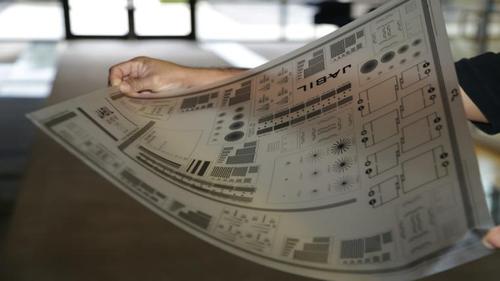3D Printing Electronics Is All the Rage But Needs to be Qualified
October 6, 2015

Additive manufacturing offers attractive new ways to integrate electronics directly into functional products. As a result, it’s making headlines throughout the manufacturing, startup business, and general technology communities. But taking innovative new processes and properly applying them to necessary end-use conditions is an essential part of the development of any emerging manufacturing technique.

Two of the most common terminologies used in reference to additive manufacturing and electronics integration are 3D printing (typically powders or filaments but can be inks) and solution printing (typically inks). 3D printing is commonly associated with rigid, three-dimensional structures of various different geometries and sizes. Solution printing is typically associated with flexible substrates of mostly thin, flat, and compliant types. The value of solution printing is maximized when electronics are printed over a very large array, such as a roll-to-roll manufacturing format.

The boundaries between 3D printing and solution printing are fast diminishing, and both offer innovative new technology solutions. Entirely new products and markets are being built upon the advanced integration of electronics (like sensors, antennas, transistors, and resisters) directly into the devices being produced. The smart textile market is a forerunner to 3D and printed electronics, with electronic traces being deposited directly onto yarn.
While a lot of this innovation garners glamorous media attention, one must clearly understand that the road to commercialization requires stringent qualification and decision-making with a full understanding of all the characteristics of the materials. There are several steps that need to be carefully navigated when commercializing printed electronics. These are given in Figure 1, and material analysis and handling is the focus here.

Printed electronics typically involves the invention of novel materials or equipment or an innovative application of traditional equipment or materials. Since these inks replace traditional electronics, it is important to understand and develop the maturity of inks so they can be introduced to mass production. It is important to understand particularly how the characteristics of the materials, such as resistivity (for performance) or rheology (for manufacturing process control), change over time in both high-volume manufacturing of the inks themselves and then during the high-volume manufacturing of products using those inks.
MORE DESIGN NEWS ARTICLES ON 3D PRINTING:
Material characteristics, such as resistance, not only have performance impacts but also cost impacts. For example, in order to achieve the same desired product characteristics one material may have to be deposited at twice the amount of another material because of the way the material is blended.
Further, it is important to understand the cure kinetics of the material so the proper post-print cure mechanism can be defined for production at high throughputs. As part of the production process, it is important to define and understand the impact of work life (time in delivery apparatus (i.e. nozzle or mesh screen)), shelf life in storage from manufacturing, and the handling from the manufacturing of the ink to its final stages of cure.
Within industrial settings, functional materials that are essential to electronics functions travel through a manufacturing cycle that is completely controlled. This environment ensures that the materials will continue to perform to their design specification. These facts must be carefully considered when 3D printing systems outside of industrial settings are introduced.
One consideration can come from the standardization typically applied to traditional electronics. Some of these standards, such as ASTM, IPC, and JEDEC, stipulate various tests that need to be carried out to ensure that electronics can withstand various environmental impacts, such as heat, moisture, vibration, and drop. Additional tests that are also beneficial to consider for printed electronics are those for evaluating arc resistance, capacitance of insulating materials, current breakdown in through hole via connection between layers, current-carrying capacity when using multilayer printed electronics, temperature rise due to current changes in conductors, and the dielectric constant of printed electronics materials.
Printed electronics, regardless of the method of printing, would have to go through the same test regimes before it could be proven out to be a replacement for traditional electronics. IPC and other organizations are introducing standards specific to printed electronics on flexible substrates, such as IPC/JPCA-4921, Requirements for Printed Electronics Base Materials, and IPC/JPCA-4591, Requirements for Printed Electronics Functional Conductive Materials, as well as the work being published through IEC and its TC 119 committee. These may have to be applied to or adapted for 3D printed electronics in order to commercialize such solutions.
So one can see that innovative manufacturing solutions are only part of the equation. As manufacturers and device developers look to create better devices in different ways, they must also keep in careful consideration the importance of end-use conditions for the devices. In a follow-up article, I will discuss assembly process development and process test analyses required for printed electronics.
But in the meantime, I will be part of the conference program at Design & Manufacturing Texas, a Design News event at the NRG Center, Oct. 13-14. My session, on Oct. 14, is The Future of 3D Printing Electronic Components. I hope to see you there.
Girish Wable is Manager and Strategic Capability Lead for Advanced Technology at Jabil, a global manufacturing services and supply chain management company. Headquartered in St. Petersburg, Fla., Jabil provides product ideation and creation through industrialization services to leading brands. With a Bachelor of Science in Mechanical Engineering and a Master of Science in Industrial Engineering, Girish is a technology, operations, sourcing, and business solutions strategist for Jabil. With more than 20 years of global experience in electronics manufacturing, high-performance coatings, material handling, automation, additive manufacturing, and printed electronics, Girish leads business and technical strategic initiatives for the company.
About the Author(s)
You May Also Like





